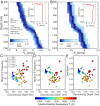Seismic detection of a deep mantle discontinuity within Mars by InSight
- PMID: 36215469
- PMCID: PMC9586319
- DOI: 10.1073/pnas.2204474119
Seismic detection of a deep mantle discontinuity within Mars by InSight
Abstract
Constraining the thermal and compositional state of the mantle is crucial for deciphering the formation and evolution of Mars. Mineral physics predicts that Mars' deep mantle is demarcated by a seismic discontinuity arising from the pressure-induced phase transformation of the mineral olivine to its higher-pressure polymorphs, making the depth of this boundary sensitive to both mantle temperature and composition. Here, we report on the seismic detection of a midmantle discontinuity using the data collected by NASA's InSight Mission to Mars that matches the expected depth and sharpness of the postolivine transition. In five teleseismic events, we observed triplicated P and S waves and constrained the depth of this discontinuity to be 1,006 [Formula: see text] 40 km by modeling the triplicated waveforms. From this depth range, we infer a mantle potential temperature of 1,605 [Formula: see text] 100 K, a result consistent with a crust that is 10 to 15 times more enriched in heat-producing elements than the underlying mantle. Our waveform fits to the data indicate a broad gradient across the boundary, implying that the Martian mantle is more enriched in iron compared to Earth. Through modeling of thermochemical evolution of Mars, we observe that only two out of the five proposed composition models are compatible with the observed boundary depth. Our geodynamic simulations suggest that the Martian mantle was relatively cold 4.5 Gyr ago (1,720 to 1,860 K) and are consistent with a present-day surface heat flow of 21 to 24 mW/m2.
Keywords: interior of Mars; mantle transition zone; thermal evolution of Mars.
Conflict of interest statement
The authors declare no competing interest.
Figures




References
-
- Halliday A. N., Wänke H., Birck J.-L., Clayton R. N., The accretion, composition and early differentiation of Mars. Space Sci. Rev. 96, 197–230 (2001).
-
- Lognonné P., Mosser B., Planetary seismology. Surv. Geophys. 14, 239–302 (1993).
-
- Banerdt W. B., et al. , Initial results from the InSight mission on Mars. Nat. Geosci. 13, 183–189 (2020).
-
- Lognonné P., et al. , Constraints on the shallow elastic and anelastic structure of Mars from InSight seismic data. Nat. Geosci. 13, 213–220 (2020).
-
- Banerdt W. B., et al. , “InSight: A discovery mission to explore the interior of Mars” in 44th Lunar and Planetary Science Conference (2013), vol. 1719, p. 1915.
Publication types
MeSH terms
Substances
LinkOut - more resources
Full Text Sources
Miscellaneous

